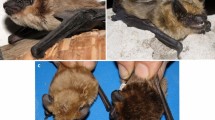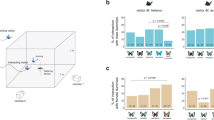Abstract
The whitebacked planthopper Sogatella furcifera exhibits wing dimorphism. The production of female macropters is most influenced by nymphal population density and is positively density-dependent. Bidirectional wing-form selection was imposed under several nymphal density conditions. Selection for increasing and decreasing the incidence of macroptery was most effective under antagonistic selection, i.e. selection for macroptery was most effective under low density conditions and selection for brachyptery was most effective under crowded conditions. Crossing experiments using the 10th generation of lines selected for macroptery and brachyptery suggest that the wing-form in S. furcifera is a threshold character under polygenic control and is determined by a threshold response to nymphal density. Broad sense heritability of wing-form was at least 0.467. The realized heritability was 0.512 estimated from the lines selected for macroptery and 0.298 from the lines selected for brachyptery. The relationship between wing-form ratio and nymphal density (i.e. reaction norm) was parallel, which proved that there was no genotype-by-environment interaction between wing-form and density.
Similar content being viewed by others
Article PDF
References
Denno, R F, Douglass, L W, and Jacobs, D. 1985. Crowding and host plant nutrition: environmental determinants of wing-form in Prokelisia marginata. Ecology, 66, 1588–1596.
Denno, R F, Roderick, G K, Olmstead, K L, and Döbel, H G. 1991. Density-related migration in plant-hoppers (Homoptera: Delphacidae): the role of habitat persistence. Am Nat, 138, 1513–1541.
Falconer, D S. 1989. Introduction to Quantitative Genetics, 3rd edn. Longman, London.
Falconer, D S. 1990. Selection in different environments: effects on environmental sensitivity (reaction norm) and on mean performance. Genet Res, 56, 57–70.
Harrison, R G. 1980. Dispersal polymorphism in insects. Ann Rev Ecol Syst, 11, 95–118.
Iwanaga, K, and Tojo, S. 1986. Effects of juvenile hormone and rearing density on wing dimorphism and oöcyte development in the brown planthopper, Nila-parvata lugens. J Insect Physiol, 32, 585–590.
Iwanaga, K, Tojo, S, and Nagata, T. 1985. Immigration of the brown planthopper, Nilaparvata lugens, exhibiting various responses to density in relation to wing morphism. Entomologia exp appl, 38, 101–108.
Jinks, J L, and Connolly, V. 1973. Selection for specific and general response to environmental differences. Heredity, 30, 33–40.
Kisimoto, R. 1956. Studies on the polymorphism in the planthoppers (Araeopidae, Homoptera). Preliminary report. Oyo-Kontyu, 12, 56–61 (in Japanese with English summary).
Kisomoto, R. 1976. Synoptic weather conditions inducing long-distance immigration of planthoppers, Sogatella furcifera Horväth and Nilaparvata lugens Stål. Ecol Entomol, 1, 95–109.
Mahmud, F S. 1980. Alary polymorphism in the small brown planthopper Laodelphax striatellus (Homoptera: Delphacidae). Entomologia exp appl, 28, 47–53.
Mochida, O. 1973. The characteristics of the two wing-forms of Javesella pellucida (F.) (Homoptera: Delphacidae), with special reference to reproduction. Trans R Ent Soc London, 125, 177–225.
Mochida, O. 1975. A strain producing abundant brachypterous adults in Nilaparvata lugens (Homoptera: Delphacidae). Entomologia exp appl, 18, 465–471.
Mori, K, and Nakasuji, F. 1990. Genetic analysis of the wing-form determination of the small brown planthopper, Laodelphax striatellus (Hemiptera: Delphacidae). Res Popul Ecol, 32, 279–287.
Morooka, S, and Tojo, S. 1992. Maintenance and selection of strains exhibiting specific wing form and body colour under high density conditions in the brown planthopper, Nilaparvata lugens (Homoptera: Delphacidae). Appl Ent Zool, 27, 445–454.
Morooka, S, Ishibashi, N, and Tojo, S. 1988. Relationships between wing-form response to nymphal density and black coloration of adult body in the brown planthopper, Nilaparvata lugens (Homoptera: Delphacidae). Appl Ent Zool, 23, 449–458.
Nagata, T, and Masuda, T. 1980. Insecticide susceptibility and wing-form ratio of the brown planthopper, Nilaparvata lugens (Stål) (Hemiptera: Delphacidae) and the white backed planthopper, Sogatella furcifera (Horvath) (Hemiptera: Delphacidae) of southeast Asia. Appl Entomol Zool, 15, 10–19.
Roderick, G K. 1987. Ecology and Evolution of Dispersal in California Populations of a Salt Marsh Insect, Prokelisia marginata. Ph.D. Dissertation, University of California, Berkeley.
Roff, D A. 1986. The evolution of wing dimorphism in insects. Evolution, 40, 1009–1020.
Roff, D A. 1994. The evolution of dimorphic traits: predicting genetic correlation between environments. Genetics, 136, 395–401.
Roff, D A, and Fairbairn, D J. 1991. Wing dimorphisms and the evolution of migratory polymorphisms among the Insecta. Am Zool, 31, 243–251.
Southwood, T R E. 1961. A hormonal theory of the mechanism of wing polymorphism in Heteroptera. Proc R Ent Soc Lond Ser A, 36, 63–66.
Zera, A J, and Holtmeier, C L. 1992. In vivo and in vitro degradation of juvenile hormone-III in presumptive long-winged and short-winged Gryllus rubens. J Insect Physiol, 38, 61–74.
Zera, A J, and Tiebel, K C. 1989. Differences in juvenile hormone esterase activity between presumptive macropterous and brachypterous Gryllus rubens: implications for the hormonal control of wing polymorphism. J Insect Physiol, 35, 7–17.
Zera, A J, and Tobe, S S. 1990. Juvenile hormone-III biosynthesis in presumptive long-winged and short-winged Gryllus rubens: implications for the endocrine regulation of wing dimorphism. J Insect Physiol, 36, 271–280.
Zera, A J, Strambi, C, Tiebel, K C, Strambi, A, and Rankin, M A. 1989. Juvenile hormone and ecdysteroid titres during critical periods of wing morph determination in Gryllus rubens. J Insect Physiol, 35, 501–511.
Author information
Authors and Affiliations
Rights and permissions
About this article
Cite this article
Matsumura, M. Genetic analysis of a threshold trait: density-dependent wing dimorphism in Sogatella furcifera (Horváth) (Hemiptera: Delphacidae), the whitebacked planthopper. Heredity 76, 229–237 (1996). https://doi.org/10.1038/hdy.1996.36
Received:
Issue date:
DOI: https://doi.org/10.1038/hdy.1996.36
Keywords
This article is cited by
-
First Report of Metadelphax propinqua (Fieber) (Hemiptera: Delphacidae) Feeding on Bermudagrass in Brazil
Neotropical Entomology (2024)
-
Dominance and inheritance patterns of mobility and death feigning in beetle strains selected for moving activity
Genetica (2023)
-
Identification of genes underlying phenotypic plasticity of wing size via insulin signaling pathway by network-based analysis in Sogatella furcifera
BMC Genomics (2019)
-
Effects of biotic and abiotic factors on phenotypic partitioning of wing morphology and development in Sclerodermus pupariae (Hymenoptera: Bethylidae)
Scientific Reports (2016)



